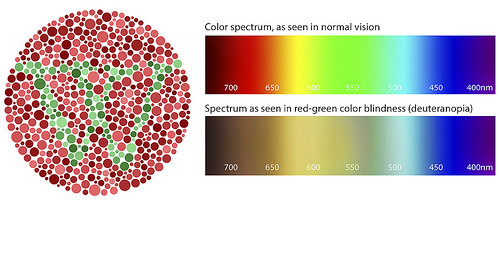
Color blindness can be caused by mutations in genes that code for the proteins OPN1MW and OPN1LW. These two genes produce proteins that play important roles in detecting and interpreting colors. These proteins are located in the retina, which is made up of three main parts: rods and cones. The rods produce visual information in low light while the cones provide color vision. Each of these parts contains a pigment that can change in different ways when exposed to different levels of light. The brain combines this input into two separate images in order to create a full picture of what is seen in the world.
People with this type of color blindness can’t perceive the green or blue parts of objects. In fact, they can’t even see red at all. They don’t even recognize that a particular color exists, such as a white ball with yellow dots on it. To help people suffering from this condition, tinted glasses or contact lenses are available. Additionally, there are color-correcting glasses available. Depending on the type of color-blindness that you have, a person can also use a color buddy who can assist them with certain tasks.
Red-green color blindness can be hereditary and occurs in 8% of men and 0.4% of women. The condition is characterized by the failure of the pituitary gland, which results in incomplete gender development and abnormal sexual organ development. In rare cases, it can also result in color blindness. In addition to these genetic conditions, aging processes can damage retinal cells and the vision processing areas. As a result, people with color blindness may struggle to recognize or interpret a specific color in the environment.
There is no specific treatment for color blindness, and people with this vision disorder can lead normal lives despite visual problems. You can find more informative information about the treatment and prevention of diseases on the website https://fablabbologna.org/. As a rule, people with color blindness can lead a normal life. Some professions can be more dangerous without color vision. For example, pharmacists and healthcare professionals depend on colored labels to indicate hazards. However, an artist or textile worker can get around this.

Some people with color blindness may not see some colors, but they can still live normal lives. Some professions are incompatible for people with color blindness, but most of them can lead productive lives. People with color vision differences can still lead normal lives. However, some careers may be more difficult for them. For example, there are professions that require the use of colored signals or danger signs. For example, the most common form of color blindness affects men and causes them to perceive red as darker than usual.
Inheritable forms of color blindness are red-green and blue-green. For these two types, the genes causing color blindness must be inherited from a mother with the X-linked gene. A father with the same mutation will not be able to pass on the gene to his daughter. But a son with a color-blind condition will inherit the X-linked genetic material from both parents.
Although color blindness is a serious health condition, most people with color vision differences can lead a normal life. In some cases, a person’s ability to recognize color can limit the types of jobs they can do. Some professions may not be suitable for someone without this disease. For example, people with this condition may find it hard to recognize objects that are in a similar shade of red. They may have difficulty reading documents and recognizing objects in other environments.
The most common form of color blindness is red-green. It is caused by a defect in the eye’s long-wavelength pigment, known as protamin. This deficiency affects the ability to distinguish between red and green. This type of color blindness affects both eyesight and contrast. A person’s vision is impaired in the same or opposite color. For people with a normal eye, color vision does not pose a problem, but some people who have a lack of it may be in danger.
Some people who suffer from color blindness can’t differentiate between colors. While it is possible to identify individual colors, this condition usually manifests itself as an inability to distinguish between different shades of red. The most common inherited form of color blindness is red-green. The affected person will experience a dimness of both red and green in mixed lights. If it is inherited, the affected person may experience a cyanosis.